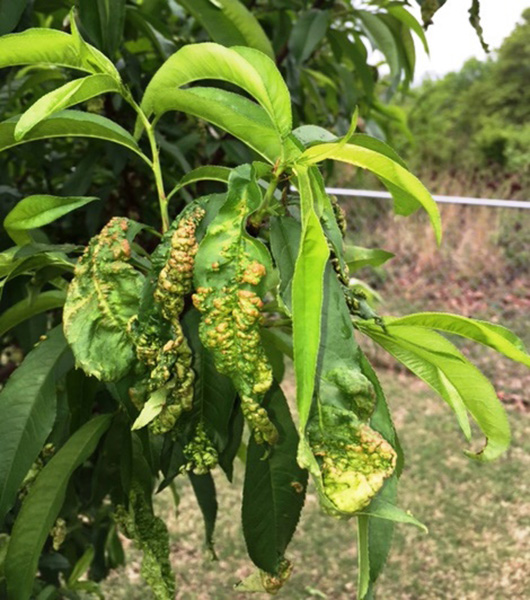Leaf Curl of Peaches and Nectarines
- Jump To:
- Symptoms
- Disease Cycle
- Control
Leaf curl of peaches and nectarines is one of the most commonly encountered diseases in unsprayed orchards and home yards during cold, wet springs. The disease can cause distortion of blossoms, leaves, fruit and shoots of the plant. In some years, the disease can cause significant defoliation and yield loss.
Symptoms
The symptoms first appear roughly two weeks after the leaves emerge. Reddish spots develop on the leaves and, as the disease progresses, these areas will thicken and pucker (Figure 1). Individual leaves may be affected or entire shoot tips may exhibit curl and distortion (Figure 2). Puckered areas on leaves may turn yellow or reddish-brown and occasionally powdery to gray spores can be observed on the leaves (Figure 3). Diseased leaves will eventually wither and fall from trees. Defoliation can result in sunburn injury on exposed branches.
Although new leaves emerge from dormant buds, their growth requirements reduce yield and may weaken diseased trees. The second flush of leaves is seldom affected by the disease. Defoliation of trees in several successive seasons may result in their death.
Figure 1. Typical symptoms of leaf curl disease on a peach leaf.

Figure 2. Peach leaves infected by the leaf curl fungus. Note puckering, deformation and change in color. Color changes usually occur long after initial infection.
Figure 3. Puckered areas on leaves may turn yellow or reddish-brown and occasionally powdery to gray spores can be observed on the leaves.
Disease Cycle
Leaf curl disease is caused by a fungus, Taphrina deformans and affects peaches, nectarines and apricots. Cherries, plums and other stone fruits (Prunus spp.) may develop similar symptoms due to other Taphrina spp. Spores of the leaf curl fungus survive the summer, fall and winter months on bud scales and twigs. During periods of moist weather in early spring, the overwintering ascospores form conidia and they are carried into the buds on a film of water. During bud swell and opening, the developing leaves become infected. Cool, wet weather slows down leaf development and provides more time for leaf infection. Infection occurs readily at 50 F to 70 F, with 68 F being optimum. As the leaves grow and mature, they become less susceptible to infection. Secondary infection rarely occurs and is unimportant. If the weather is dry during bud swell and bud break, leaf curl is limited, and may not occur. However, the fungus may survive to infect trees another season.
The leaf curl fungus not only infects leaves, but also tender growing shoots and,
more rarely, blossoms and fruits. Infected twigs become slightly swollen, may be yellowish
and remain stunted. Infected blossoms and fruit usually fall early in the season.
However, some infected fruit may remain in the trees. Diseased fruit will show shiny,
raised, warty, discolored areas (Figure 4).
Figure 4. Fruit infected by the leaf curl fungus.
Control
Leaf curl is one of the relatively few serious diseases which may be easily, economically and effectively controlled. If a recommended fungicide is applied at the correct time, 95% to 98% control is usually obtained. A fungicide spray is most effective when applied just before swelling of the buds. Timing depends on temperature and rainfall pattern of the season in each area of the state, usually around March. In commercial practice, an earlier application is frequently made. Ordinarily, only one application is required, but if bud opening is delayed due to cold weather or if frequent rainfall occurs, a second application may be required. A fall application after leaf drop may also be helpful.
It must be remembered that leaf curl cannot be controlled after the fungus has infected the leaves and fungicide applications must be made before the buds begin to swell. Thorough and complete coverage of twigs, branches and trunks is required. For suggested fungicides refer to the current OSU Extension Agents’ Handbook of Insect, Plant, Diseases and Weed Control.
When leaf curl is severe, maintenance of tree vigor is very important. Fruit should be thinned to compensate for the loss of leaves. Over-cropping a tree will weaken it and make it more susceptible to winter injury. Trees should be adequately irrigated, and additional nitrogen fertilizer may be helpful for trees that are defoliated.



